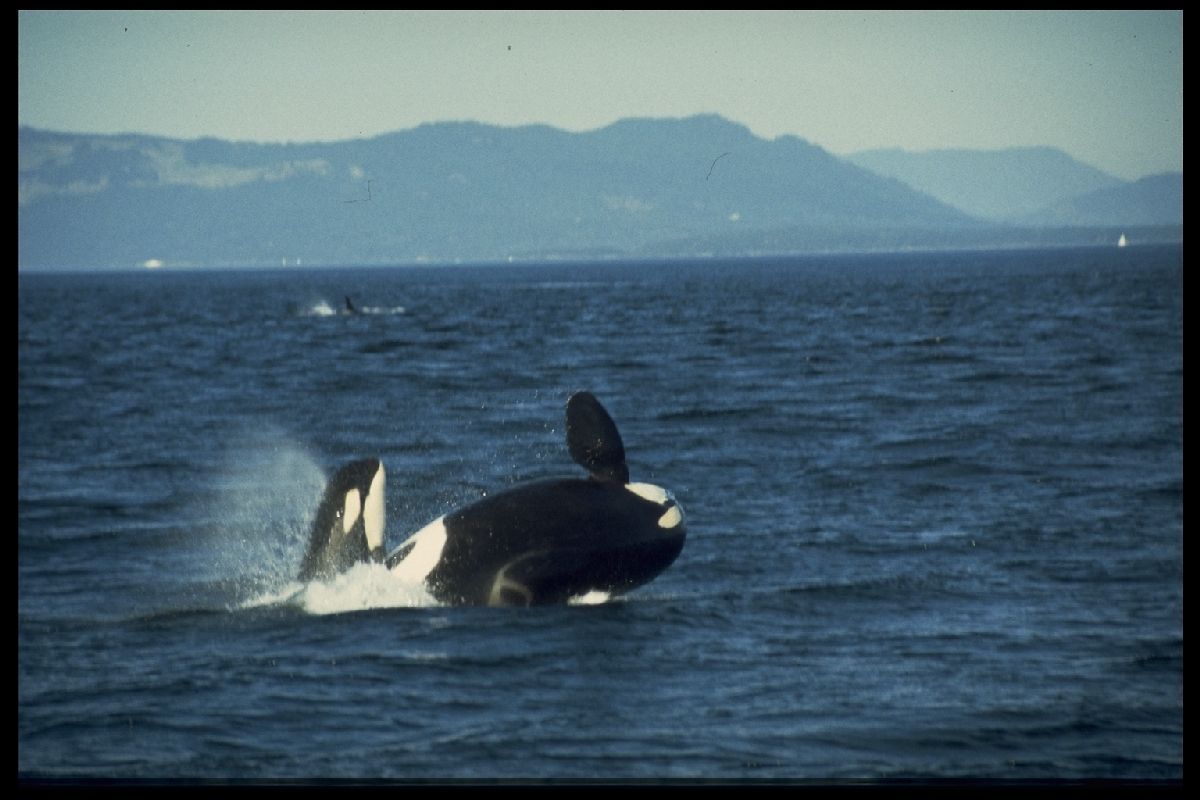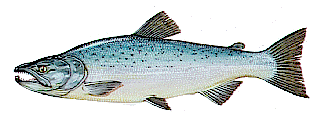|
WHAT IS AN ORCA?
|

|
Residents - Behaviour
RESTING:
Orcas most commonly rest in their social groups while swimming slowly (2
knots or less) close together, closely synchronizing their breathing. Orcas
also rest quietly while lying almost motionless on the surface of the water,
usually with other members of their immediate family close by. They are very
quiet during these rest periods, emitting just a few, short, discrete sounds.
Resting at the surface may last for a few moments or for quite long periods
of time, even hours. It often seems as if one member of the group will remain
more attentive then the rest. Sometimes the young calves have difficulty
remaining as still as the adults. After a while the frequency of the short
calls increases until finally one whale gives a louder "wake up" call. Then
the activity within the group will pick up and the group will travel onwards,
rest over.
TRAVELLING:
When orcas are "travelling" the group members are all headed in the same
direction and are usually distanced not far from each other. Travel speeds
vary from about 3 to 12 knots. Sometimes when the group has traveled long
distances to reach a desired area there are periods of silence interspersed
with periods of intense vocal activity. The Northern Resident Community
whales generally arrive in the Johnstone Strait area from the north. As they
enter into the Strait they seem to "announce" their arrival to the other
whales that are already in the area. These "announcement" calls may have
been preceded by complete silence until the orcas enter into Johnstone Strait
proper. When large groups of whales arrive and head into the area there is
often a lot of intense vocal activity. At these times there is a great deal
of excitement, both for the whales and the human listener alike.
FORAGING:
In the summer and fall seasons the whales take advantage of the abundance
of the annual salmon runs, so there is a lot of feeding (foraging) behavior.
Although orcas generally fish individually, they probably coordinate their
movements as a group to maximize their chances for success. The group ( whether
it is a small maternal group, several maternal groups or several pods) usually
spreads out over an area. Together they will move in the same direction.
Quick, brief changes in direction indicate that a whale has located a fish.
In other places in the world, such as Norway, orcas have been filmed
cooperatively hunting herring by forcing the fish into a tight ball after
startling them. Then, by using their flukes, some whales in the group stun
the fish while others take the advantage and feed.
|
indispensable for the survival of the Pacific NW resident orcas: salmon
|

|
In other places orcas have "pushed" fish into shallow waters to allow other
members to feed. Sometimes orca behaviour is molded by the different types
of salmon present. Sockeye salmon tend to swim in the cooler depths, which
encourages the whales to make longer and deeper dives. The Chum salmon, however,
swim closer to the surface in large schools which get caught up in the strong
tide rips. In the Fall it is not unusual to see large groups of whales
"working" one of these tide rips, spending hours shallow diving, picking
off fish one after another. The large Chinook (Spring or King) salmon stake
out their own individual areas. They like to be near to the rocky crevices
along the shoreline. When the orcas locate one of these fish the chase is
on. Sometimes the fish evades the whale and manages to hide in a crack. The
whale does not give up easily and will worry over the spot for quite a while,
even trying to flush out the fish by undulating his or her body up and down
in an attempt to make travelling waves. Other group members may help out
by doing a similar movement. Remarkably, orcas suffer very few serious abrasions
during these efforts. Occasionally, a whale will even chase a salmon right
onto the shore in shallow water and then have to wriggle back into deeper
water! The whales may or may not be vocal during foraging, but usually there
is some vocal activity as they keep in touch with each other. There
is an increase in the use of echolocation clicks as orcas zero in on prey
fish.
SOCIALIZING:
Orcas are very social animals. During the summer season, when they are observed
the most, they spend many hours intermingling with one another... with other
maternal groups, with pods from the same clan and with pods from different
clans. In the Northern Resident Community, preceding the arrival of a new
group, one of the more frequent user groups may leave the area in order to
"escort" the new group into the area. As they enter Johnstone Strait the
whales often pause in their travel. Other orcas in the area may come toward
the arriving groups, and together they may (often after an intense vocal
period) all go quiet, rest on the surface and socialize with each other.
This latter state may include spy-hopping (where the head is thrust out of
the water), rubbing bodies together, full breaches (where the whole whale
jumps free of the water), fluke (tail) and pectoral slaps, and deep diving.
Sometimes these same behaviors are exhibited by the whales coming to greet
the incoming whales, but they calm down when the groups near each other.
On these occasions the greeting whales may turn around before the visiting
groups and travel ahead of them. Either way, the whales will usually sort
themselves into their maternal groups and then all head in the same direction.
For the Northern Resident orca, after they resume travelling, they will most
likely head for the Robson Bight area and the Rubbing Beaches beyond.
These Rubbing Beaches are a unique feature of the area. Though whales have
been observed rubbing in other shallow areas, their use of these particular
beaches is very consistent and well documented. It seems to be an important
part of their traditional use of the Johnstone Strait area. The beaches are
covered with small, flat, round and smooth stones. The whales dive, blow out
air as bubbles to lessen their buoyancy, and then skim their bodies over the
stones. Sometimes several whales will use the beach at one time, but they will
also take turns, waiting a short distance offshore for their turn. This activity
brings the whales very close to shore. Again, they may or may not be vocal as
they are rubbing.






